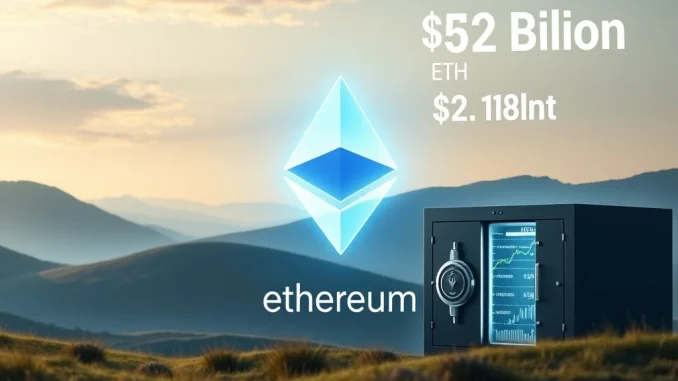
In a groundbreaking move that’s sending ripples across the digital asset landscape, Bitcoin mining giant BitMine Immersion Technologies has just unveiled a strategic pivot, revealing an astonishing $2 billion in Ethereum (ETH) reserves. This isn’t just another headline; it’s a powerful statement about the evolving nature of institutional engagement with cryptocurrencies, specifically highlighting a surge in Ethereum staking post-Merge. For anyone tracking the pulse of the crypto market, this development signals a significant shift and a growing wave of institutional confidence in Ethereum’s long-term utility.
What’s Behind BitMine’s Monumental Ethereum Staking Move?
For years, BitMine Immersion Technologies (BMNR) was synonymous with Bitcoin mining, a powerhouse in the proof-of-work realm. Yet, their recent announcement, confirming holdings of 566,776 ETH as of July 23, marks a calculated departure from their Bitcoin-centric operations. This substantial accumulation positions BitMine among a select group of publicly traded companies daring to diversify their treasury assets beyond traditional crypto mining.
- Strategic Diversification: While Bitcoin remains a dominant force, Ethereum’s ecosystem, with its sprawling decentralized finance (DeFi) applications, non-fungible tokens (NFTs), and foundational role in Web3, offers distinct growth avenues. BitMine’s move acknowledges these alternative vectors.
- Yield Generation: The key differentiator here is Ethereum staking. By holding and staking ETH on the proof-of-stake network, BitMine transforms its assets from static holdings into revenue-generating tools. This passive yield opportunity provides a compelling financial incentive, turning a digital asset into an income stream.
- Embracing Web3 Foundations: This isn’t just about speculation. BitMine’s significant investment underscores a recognition of Ethereum as a core infrastructure for the decentralized internet, moving beyond its initial perception as merely a volatile token.
Why Does This Spark Unprecedented Institutional Confidence in ETH Reserves?
The sheer scale of BitMine’s ETH reserves — exceeding $2 billion — sends a powerful signal to the broader financial world. When a New York Stock Exchange-listed entity makes such a public and substantial commitment, it often encourages other traditional firms to re-evaluate their own digital asset strategies. This isn’t just a ripple; it’s a potential wave of institutional adoption.
Ethereum’s transition to a proof-of-stake model, known as ‘The Merge,’ has been a game-changer. It not only significantly reduced Ethereum’s energy consumption but also introduced native staking rewards, attracting over $10 billion in staked assets globally. BitMine’s participation amplifies this trend, contributing to increased demand for ETH and potentially reducing its circulating supply, which could, in turn, positively influence price appreciation.
This development reinforces the narrative that Ethereum is maturing from a speculative asset into a foundational technology. Institutions are increasingly looking at blockchain solutions for real-world applications, and Ethereum, with its robust developer community and established ecosystem, stands out as a prime candidate. This growing institutional confidence is crucial for the long-term stability and growth of the entire crypto space.
BitMine’s Bold Strategy: A Game-Changer for the Crypto Market?
The implications of BitMine‘s strategic shift extend far beyond its balance sheet, potentially setting a new precedent for how publicly traded companies approach digital asset management within the broader crypto market. This move validates Ethereum’s evolving utility, showcasing its adoption in decentralized applications and its role in blockchain innovation as increasingly recognized by sophisticated investors.
However, such bold moves are not without their challenges. The inherent volatility of crypto markets, ongoing regulatory uncertainties, and the paramount need for robust security measures to protect billions in digital assets remain significant considerations. BitMine’s decision highlights the complex balancing act required: managing liquidity, ensuring security, and optimizing for yield opportunities while navigating an evolving regulatory landscape.
For the average investor, BitMine’s actions reinforce the importance of diversification and fundamental analysis in crypto portfolios. While the company’s strategy is not entirely unique – other mining firms have explored multi-asset approaches – its public disclosure of a $2 billion ETH hoard sets a high bar for transparency and institutional adoption, demonstrating a growing professionalism within the sector.
Actionable Insights for Your Portfolio
What can you take away from BitMine’s pioneering move? Here are some key considerations:
- Diversification is Key: Don’t put all your digital eggs in one basket. Just as BitMine is diversifying from Bitcoin, consider a balanced portfolio that includes foundational assets like Ethereum.
- Understand Yield Opportunities: Explore staking, lending, and other DeFi protocols to potentially generate passive income from your crypto holdings, but always research the risks involved.
- Focus on Fundamentals: Look beyond price charts. Investigate the underlying technology, use cases, and institutional adoption of a cryptocurrency before committing. BitMine’s move is a testament to Ethereum’s strong fundamentals.
- Stay Informed on Regulation and Security: As institutional players enter, the regulatory landscape will continue to evolve. Prioritize secure storage solutions for your assets.
The Future Is Bright: A Compelling Conclusion
BitMine Immersion Technologies’ monumental $2 billion Ethereum staking initiative marks a pivotal moment in the digital asset space. It’s a clear indicator of burgeoning institutional confidence in Ethereum’s long-term value and its role as a cornerstone of the decentralized economy. This strategic allocation of significant ETH reserves by a major publicly traded company not only validates Ethereum’s evolving utility but also sets a powerful precedent for other corporate treasuries eyeing the crypto market.
As Ethereum’s ecosystem continues its rapid expansion, such strategic allocations may become increasingly common. This shift reshapes perceptions of digital assets, moving them from speculative tools to core components of diversified financial portfolios. BitMine’s move is more than just a company announcement; it’s a testament to the maturation of the crypto sector and a beacon for future institutional engagement.
Frequently Asked Questions (FAQs)
Q1: What is Ethereum staking and why is BitMine doing it?
Ethereum staking involves locking up ETH to support the network’s security and operations on its proof-of-stake blockchain. In return, stakers earn rewards (yield). BitMine is doing it to diversify its assets, generate passive income from its substantial ETH reserves, and capitalize on Ethereum’s role in the Web3 ecosystem.
Q2: How does BitMine’s $2 billion ETH reserve impact the crypto market?
BitMine’s large ETH reserve and staking commitment signal strong institutional confidence in Ethereum. This could encourage other large firms to invest, potentially increasing demand for ETH, reducing its circulating supply, and further legitimizing the asset class for mainstream finance.
Q3: Is Ethereum now considered a safer investment due to institutional adoption?
While increased institutional adoption, like BitMine’s, adds legitimacy and stability, no cryptocurrency is entirely ‘safe’ due to inherent market volatility and evolving regulatory environments. However, it does indicate a growing recognition of Ethereum’s fundamental value and utility beyond pure speculation.
Q4: What are the risks associated with such a large institutional investment in crypto?
Key risks include market volatility, which can significantly impact the value of holdings; regulatory uncertainty, as governments worldwide are still defining crypto frameworks; and security concerns, as large digital asset holdings are attractive targets for cyberattacks. Robust risk management and security protocols are crucial.
Q5: How does this move relate to Ethereum’s ‘Merge’ to Proof-of-Stake?
The Merge was Ethereum’s transition from a proof-of-work to a proof-of-stake consensus mechanism. This transition enabled native staking, allowing ETH holders to earn rewards for securing the network. BitMine’s $2 billion staking move is a direct utilization of this post-Merge capability, leveraging the new economic model of Ethereum.



